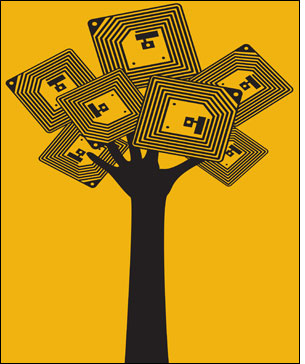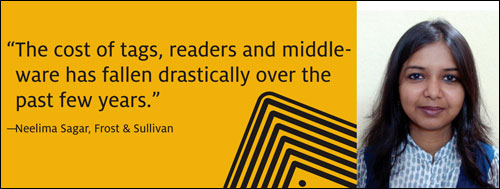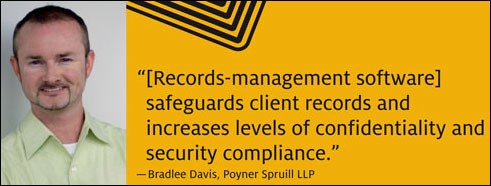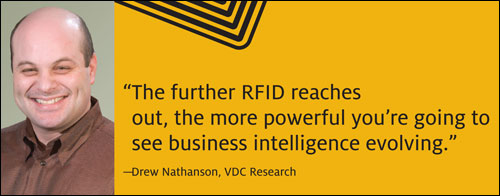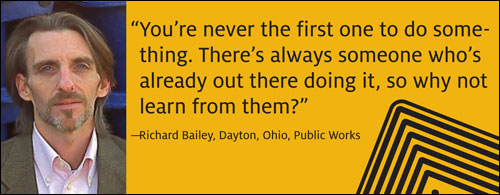Apr 01, 2011There's a lot to be said for hard work, struggle, perseverance and guiding a maddeningly complex and expensive project to its ultimate conclusion. But there's much more to be said for plunking down a purchase order or credit card, popping open a box and watching your new toy run. RFID isn't quite yet at the "popping open the box" stage, but there's no denying that RFID systems have become much easier to design and deploy over the past few years.
Although RFID's roots stretch all the way back to the 1940s, only over the past decade or so has the technology gained any serious business traction. While RFID is now used by enterprises worldwide for an almost endless number of tasks, many companies that could benefit from the technology have shied away from it, deterred by cost, complexity and/or operational concerns.
Yet, almost faster than an interrogator can read a tag, RFID's roadblocks are falling away. Lower costs, improved technologies, sturdier standards, specialized applications and a variety of other advancements are propelling RFID adoption in much the same way cheap and powerful desktop computers first brought businesses into the digital age.
"Price points are coming down, innovations continue and… there's a lot of application-centric development taking place in the market," says Michael J. Liard, RFID practice director at ABI Research, a technology research firm. "Many businesses have always wanted RFID—now they're getting to the point that they're more likely to act on their desire."
"Money talks, but it only says goodbye," the old joke goes. But it was no joke to early adopters considering an initial RFID deployment or a system upgrade. Today, falling costs mean end users don't have to invest as much money in RFID technology, and the cash they do spend usually comes back to them. If a project meets or exceeds its performance goals, the money returns quickly, with more in tow. Return on investment benefits are becoming easier to achieve, because vital system components keep getting less expensive and more powerful.
"The cost of tags, readers and middleware has fallen drastically over the past few years," says Neelima Sagar, a senior research analyst at Frost & Sullivan, a technology research firm. "These prices are expected to go down even further as the adoption of RFID technology continues to gain momentum globally." Tag prices mostly held steady or rose slightly in 2010 due to increasing demand and other factors, but most observers see this as a temporary blip in a steady march to lower prices.
Falling prices are inspiring enterprises that once rejected RFID due to cost concerns to rethink their position. "A company that didn't invest in RFID five years ago should look at it again if cost or performance was the main determining factor for not moving forward with a project," advises Kurt Mensch, principal RFID product strategist with Intermec, an RFID systems vendor. "The situation has changed dramatically for the better."
Many business giants are helping to drive down RFID costs by requiring their partners to adopt the technology, bringing economy-of-scale benefits to all, says Jeff Hudson, president of Smart Label Solutions, a provider of RFID software applications and system solutions. "Big guys like Wal-Mart, which just announced a big push on apparel item-level tagging, drive the cost down," he says. "It makes the adoption of the technology much more palatable for the companies we talk to."
In many markets, falling prices can be a sign of poor quality and less reliable products. Yet exactly the opposite is happening in RFID, where readers, tags and other system components all have grown more powerful and capable over the past few years, despite declining prices. Improved hardware also means adopters don't have to spend as much time and money getting initiatives up and running, encouraging the deployment of more complex and innovative systems.
"Tags have become faster and more reliable, giving customers more confidence in their RFID data and providing them with greater visibility and improved efficiency in their operations that cannot be obtained with any other technology," Mensch says. "These added capabilities allow venturing into new applications."
Active tag customers, in particular, have benefitted from major performance upgrades, as well as falling prices. "The active tag market is witnessing a continuous cycle of innovation, which, in turn, results in various features to meet end-user needs," observes Frost & Sullivan's Sagar. "Apart from offering real-time visibility to tagged products, next-generation active tags also provide end users with accurate location tracking with a high degree of accuracy."
Tags aren't the only RFID technology that's constantly improving. Readers also are becoming more sophisticated. One example of reader technology advancement is the availability of RFID readers with embedded middleware, Sagar notes. "With these intelligent readers, which do not require a separate server to host the middleware locally, the time to market and the total cost of ownership of a deployment can be greatly reduced," she says. "Advancements in RFID technology have made and will continue to enable and drive the adoption of RFID technology in traditional applications as well as in emerging applications."
As more RFID systems are deployed, and software developers grow increasingly knowledgeable about the technology, a new generation of powerful RFID application software is taking root. Today's software is capable of tracking nearly anything imaginable, including apparel, artwork, equipment, livestock, people, pharmaceuticals and vehicles. "If you can tag it you can track it, and there will be an application to support it," Liard says.
FileTrail records-management software, for example, helps Bradlee Davis, director of records and information management for Poyner Spruill LLP, a law firm headquartered in Raleigh, N.C., to pinpoint the locations of critical files. "We can walk into any file room or office with the RFID scanner, sweep the shelves and boxes, and it's going to read the RFID tags and update the location of the files in our system," he says. "Anything moved during that week will be picked up in that particular scan; it safeguards client records and increases levels of confidentiality and security compliance."
Beyond applications, the system software that's used to connect RFID readers and other components to enterprise computers is also improving. While middleware functions invisibly, it has a big impact on RFID system performance, functionality and, ultimately, cost. "Enterprise middleware suites are shifting toward service-oriented architecture," Sagar says. "One of the key benefits gained from an SOA-based middleware solution is reduction of the total complexity of a system, thereby reducing integration expense."
4. Standards, Guidelines and Initiatives
Maturing standards have helped smooth the way for adoption, making RFID a technology that can be used successfully by enterprises in a wide array of fields. Now, standards-setting organizations are working more closely with adopters to create guidelines and benchmarks that precisely match real-world needs, Liard says.
In November, Voluntary Interindustry Commerce Solutions (VICS) and standards groups GS1 US and GS1 Canada teamed up with apparel retailers, goods manufacturers, retail associations and technology providers to develop recommendations for EPC RFID tagging at the item level, to be used by retailers and their suppliers. The goal of the Item Level RFID Initiative is to provide a set of guidelines—first for the apparel industry, then for general merchandise retailers and suppliers—to head off incompatibility issues, such as suppliers being asked to use different RFID tag-data specifications for different stores.
In aviation, most RFID-enabled baggage-handling systems now rely on tags designed to comply with standards set by the International Air Transport Association (IATA). Aalborg Airport, on the northern part of Denmark's Jutland peninsula, recently replaced its bar-code-based baggage-handling system with a Lyngsoe Systems deployment that uses RFID tags complying with the IATA 740c specification. "IATA was in favor of RFID, and they support us with their technology," says Søren Svendsen, the airport's CEO.
In an effort to turn mobile phones into wireless credit cards, the three largest U.S. mobile phone carriers—AT&T Mobility, T-Mobile USA and Verizon Wireless—have launched a joint venture known as ISIS, to create specifications for Near-Field Communication payment systems. Merchants have been seeking a standard platform, to avoid incompatibility issues among retailers, financial institutions and mobile carriers. The group intends to release software for handsets and payment terminals in select U.S. regions over the next 18 months, with a nationwide rollout by 2013.
To help construction and engineering firms deploy RFID, FIATECH, a consortium of industries and technology providers, sponsors pilots and provides written materials on the technical and financial aspects and best practices of RFID. In the financial services industry, the Financial Services Technology Consortium, a New York-based organization comprising North American financial institutions, technology vendors, research groups and government agencies, develops RFID standards for applications, such as tracking IT assets in data centers.
Over the next few years, the Dash7 standard promises to make RFID technology easier to deploy for a greater number of enterprises by boosting RFID interoperability with existing systems and procedures, says Drew Nathanson, director of research operations at VDC Research, a technology research firm. The Dash7 Alliance, a nonprofit consortium, has created a global standard for active RFID technology. The group recently introduced a new specification, known as Mode 2, that will allow the integration of 433 MHz active and 13.56 MHz passive RFID on a single tag. It also will enable tag-to-tag transmission and a range of new applications.
Until recently, RFID was viewed as little more than a sophisticated item-tracking and inventory tool. But a new generation of business intelligence (BI) products are helping RFID gain widespread recognition as a business analysis and planning resource. "The further RFID reaches out, the more powerful you're going to see business intelligence evolving, and there will be more infrastructures growing up to support it," Nathanson says. "I'm seeing a lot of these applications being developed with suppliers, systems integrators and VARs."
Already, visibility is providing high-quality business information that is being used by manufacturers, apparel retailers, warehouse managers and others to make smarter decisions (see RFID: The Key to Knowledge). Software solutions let you analyze RFID-generated data, then act on the information to identify and solve a problem, and discover opportunities to improve business processes.
In Dayton, Ohio, BI software plays an essential role in increasing residents' participation in the city's trash-recycling project. Tagged bins, truck-mounted readers and BI software, supplied by CDO Technologies, allow program mangers to continuously study and evaluate program participation, "not just to see who's in and who's not, but also to educate the ones who aren't—maybe to offer incentives to those who are [in]," says Richard Bailey, geographic information systems coordinator for Dayton's department of public works. "All in all, it's a justification of this program."
Serge Blanco, a clothing retailer based in Toulouse, France, has connected its companywide RFID environment, supplied by Tagsys, to its enterprise resource-planning system to create on-screen information dashboards showing the real-time status of inventory and orders. "We expect to accelerate and improve our process flows at our distribution center and, above all, increase the availability of merchandise in the stores to increase our sales revenues," says Matthieu Pradier, Serge Blanco's VP of operations.
In the past few years, RFID technology providers have been transforming horizontal asset-tracking solutions into vertical offerings for hospitals, manufacturers, retailers, warehouse operators and other organizations that work in broad, well-defined fields. Vertical industry vendors tend to be fully in tune with their customers' unique needs, Nathanson observes.
"It's about having a specialist come in who offers a solution that's almost customized or tailored for your application," he says. "A specific supplier who focuses on health care, who understands the health-care nuances and the processes and the pains that these facilities go through, is much better suited to provide a packaged solution that can fit in easier and be much more cost-effective," he says.
"The trend is moving toward providing complete solutions," says Frost & Sullivan's Sagar. "This trend is anticipated to drive RFID adoption in the long run, making it easier for an end user to choose the right vendor and the right technology."
RFID is also creating footholds in areas that just a few years ago were considered too unique or insignificant to target, including specialized applications within health care, hospitality, government and recreation. This development, besides delivering appropriate, affordable technologies to customers in niche sectors, is flattening the learning curve, making RFID less intimidating to new adopters. Hospitals, for example, are installing RFID-based hand-washing dispensers and using RFID to track surgical sponges. Bars and restaurants are adopting RFID drink-management solutions, museums are using the technology to make exhibits interactive, and marathon organizations are using RFID-enabled race-timing systems.
The trend toward more packaged solutions will make it easier for organizations in specific verticals to deploy RFID systems, Nathanson says. "You're starting to see this now emerging in markets like libraries, where it's all more or less the same kind of system or the same kind of processes," he says. "There might be little nuances in the installation environment that you have to play around with and tweak, but for the most part, it's all the same set of product types or solution sets."
A substantial amount of RFID literature has been created over the past few years, much of it available on the Web. For new RFID adopters, or for those expanding or improving current systems, research materials such as white papers, case studies, magazine articles and books can serve as detailed roadmaps to project success. After reading about various types of RFID technologies, and understanding how other enterprises have succeeded with specific types of RFID deployments, project leaders can talk more knowledgeably to vendors and system integrators about their exact needs.
"We have more educated customers and organizations today, and they have more awareness about RFID," says Ali Khaksar, president of TagMaster North America, an RFID systems vendor. "It was not like this five years ago, when people didn't always know about RFID. When I talk with customers today, they know about this technology."
New adopters would be foolish not to take advantage of the rapidly snowballing collection of RFID insight, Dayton's Bailey says. "You're never the first one to do something," he observes. "There's always someone who's already out there doing it, so why not learn from them?"
Bailey points out that his organization's project originated with Tom Ritchie, division manager of waste collection for Dayton's department of public works. Ritchie is a voracious reader of RFID literature who's "always looking at what other people are doing, who's doing it right, how it's saving them money and how we can save money," Bailey says.
Looking into the future, analysts predict the RFID industry will continue its steady evolution toward better, less costly, more powerful technologies, and stronger standards. These ongoing developments will support real-world innovation, leading RFID to be used in ways currently unimaginable.
Meanwhile, despite all the progress the industry has made in recent years, there's still a large untapped pool of companies waiting to be convinced that the technology is the right solution for their processes, Liard says. "With each step forward, RFID becomes a viable choice for an incrementally larger number of enterprises," he says. "It's an inevitable progression."

